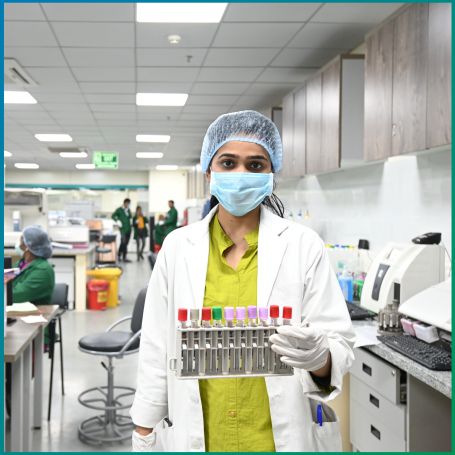
The C/S Drain Tip Test is a diagnostic procedure used to detect infections in surgical drains, which are commonly used to remove fluids such as blood or pus from body cavities after surgery.

These drains help prevent complications like hematomas, seromas, and infections, but they also present a potential site for bacterial growth. If the drainage becomes infected, it can lead to severe complications and delay recovery. The C/S (Culture and Sensitivity) Drain Tip Test plays a crucial role in identifying the causative pathogens and determining the appropriate antibiotic or antifungal treatment, ensuring that patients recover safely and without complications.
1] Early Detection of Infection - Infections associated with surgical drains can be subtle at first, but if left untreated, they can lead to severe complications like abscess formation, sepsis, or delayed wound healing. The C/S Drain Tip Test helps detect infections early by identifying harmful microorganisms in the drain, enabling quick intervention.
2] Identifying the Causative Organism - The test identifies the specific bacteria or fungi causing the infection. This is crucial because different microorganisms require different treatments. For instance, an infection caused by Staphylococcus aureus might require a different antibiotic compared to an infection caused by Pseudomonas aeruginosa. Identifying the pathogen ensures that the correct treatment is chosen.
3] Guiding Antibiotic or Antifungal Therapy - Once the microorganism is identified, the sensitivity test provides valuable information on which antibiotics or antifungal agents are effective. This targeted approach helps to prevent the overuse or misuse of antibiotics, reducing the risk of antibiotic resistance and ensuring faster recovery.
4] Preventing Complications - Surgical drain infections, if not properly treated, can lead to severe complications, including wound dehiscence (reopening), delayed healing, or the development of abscesses. The C/S Drain Tip Test helps prevent such outcomes by ensuring that infections are promptly and effectively treated.
1] Sample Collection - The test begins with the collection of a sample from the tip of the surgical drain. This is typically done using a sterile swab or a small syringe to aspirate fluid from the tip of the drain. The sample should be collected under aseptic conditions to avoid contamination.
2] Transport to the Laboratory - Once collected, the sample is transported to a laboratory where it will be cultured to detect the presence of microorganisms. The sample is placed in a culture medium, where any bacteria or fungi present will grow.
3] Culturing and Identification - In the laboratory, the cultured sample is monitored over several days. If microorganisms are present, they will grow and form colonies, which are then identified based on their characteristics, such as shape, color, and growth pattern. More advanced methods, like molecular tests, may also be used for faster identification of pathogens.
4] Sensitivity Testing - Once the pathogen is identified, antibiotic sensitivity testing is performed. This involves exposing the isolated microorganism to different antibiotics to determine which are effective in inhibiting growth. This information is used to prescribe the most appropriate treatment for the infection.
5] Result Interpretation - The results of the C/S Drain Tip Test typically take 48 to 72 hours, depending on the type of pathogen and the laboratory's processing time. A positive result indicates the presence of infection, and appropriate antibiotics or antifungal treatment will be prescribed based on the sensitivity profile.
Choosing the best pathology lab near me for the C/S Drain Tip Test ensures reliable, accurate, and efficient diagnostics for surgical drain infections. Diagnopein is known for its high-quality testing methods, providing fast and precise identification of pathogens from surgical drain samples. Their advanced culture techniques and sensitivity testing allow healthcare providers to quickly determine the exact microorganism causing the infection and identify the most effective antibiotics or antifungal treatments. With a strong track record of consistent results and a reputation for excellence in microbiological testing, Diagnopein helps clinicians make informed decisions, minimizing the risk of complications and improving patient outcomes. Additionally, Diagnopein's focus on customer care, ease of use, and timely results make it a trusted choice for diagnosing and managing surgical drain infections in clinical settings.
1. Culture Method
2. Sample
3. Colony Count
4. Organism(s) Isolated
5. Culture Report: Culture yields growth of
6. Culture isolated after 7 days :
7. Culture isolated after 14 days:
8. Culture isolated after 21 days:
9. Ampicillin
10. Amikacin
11. Amoxicillin clavulanate
12. cefoperazon+sulbactam
13. Cefuroxime
14. Cefepime
15. Cefotaxime
16. Ciprofloxacin
17. Ertapenem
18. Gentamicin
19. Imipenem
20. Meropenem
21. Norfloxacin
22. Nitrofurantoin
23. Piperacillin-tazobactam
24. Trimethoprim-Sulfamethoxazole (Cotrimoxazole)
It is performed to identify and treat infections in surgical drains, ensuring appropriate antibiotic or antifungal therapy is administered to prevent complications like abscesses, delayed healing, or sepsis
It can detect bacterial, fungal, or parasitic infections that may develop at the surgical drain site, such as surgical site infections, abscesses, or chronic drain infections.
The test involves a simple swab of the drain tip, which is minimally invasive and generally not painful for the patient.
A sample is collected from the tip of the surgical drain using a sterile swab, which is then cultured in a laboratory to identify pathogens and perform sensitivity testing for appropriate treatment.